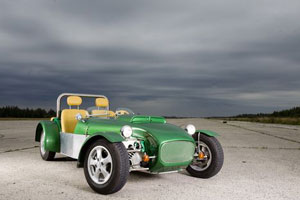Estonia, EU – Baltic States, Technology, Transport
International Internet Magazine. Baltic States news & analytics
Friday, 26.04.2024, 09:34
ZEV Motors plans to develop Europe's most efficient electric cars
 Print version
Print version |
|---|
"It's difficult to make a breakthrough with electric cars in Estonia because to Estonians the car is a status symbol, and not the most economical means of transportation. But in a few years the price of a litre of petrol will be two euros – then attitudes will change!" Randma says.
A pioneer in the electric car industry, ZEV has taken the initiative, aiming to become the representative for many internationally known brands, as well as boldly developing its own products – in other words, the Estonian e-car industry.
The first prototype of the Estonian electric sports car, the ZEV Seven, was launched in 2008. In early November this year Randma and his business partner Merilo who owns the legendary electric Pobeda, presented the Seven at the 2009 Electric Motor Show in Helsinki.
Different transportation solutions were presented there, from e-bicycles and e-scooters to the few electric cars currently sold on the European market.
The Estonians' Seven, which is yet to go into production, was remarkably one of only three cars to leave the show powered by its own engine. Others, including Tesla Roadster (co-funded by Estonian venture capitalist Steve Jürvetson) and the Norwegians' Th!nk City were "pushed" out of there.
While the renowned Tesla Roadster costs upwards of approximately 64,000 euros (plus taxes), the ZEV Seven basic model comes in at a third of the price.
The Seven is not a family car, but a kit car. The engine of the five-gear manual two-seater vehicle is manufactured in the USA and the basic model uses eight lead batteries which take about 8 hours to charge, when connected to a standard 220V plug.
Depending on the speed at which you drive, the batteries last for 50-90 kilometres and the journey hardly costs a thing (in the city the energy cost is 10 cents/km). It can even reach speeds of 120 km/hr.
So a Seven-trip from Tallinn to Tartu can't be done yet on a single charge cycle – that would require expensive lithium batteries with a higher energy capacity and a quick recharge – cause it's unthinkable to recharge the batteries during that journey, as it would take a full 24 hours for that.
The men from ZEV have done all the electric works, but the bodywork was created by Valter Teppan's company, Võidusõidutehnika AS. The bodywork is similar to that of the Lotus 7, designed by Colin Chapman in 1957. Many Russian Lada parts have been used in the Seven prototype, including the tachometer, swivels, steering shafts and brake discs.
The yellow leather trim may be flashy, but the assembling quality is poor, to say the least. All of the comfort fittings have been removed from the basic model to keep the price low.
According to Randma, the first model has been deliberately made with certain features as optional extras.
The first order will most likely be delivered to Finland, because in Estonia the number of genuinely interested people can be counted on the fingers of one hand. At the moment, people are more interested in converting internal combustion motor vehicles to electric power. No electric cars are offered in Estonian car dealerships since the market for the Tesla, Th!nk, Reva or other electric cars is too small.
Urmas Roosma, an Estonian farmer who produces and sells electricity from his hydroelectric plant in the district of Halliste, has paid ZEV almost 10 000 euros to convert his Volkswagen Golf to run on electricity. This enables him to commute to his workplace in the town of Viljandi, 25 kilometres away, almost free of charge.
"Oil consumption will come to an end," he claims. "In five years there will be many electric vehicles in Estonia."
Skeptics agree that the enthusiasts behind ZEV may be part of the "engine of progress", but with their ambitious plans they may have lost touch with reality.
Electric cars in Estonia number less than a dozen at the moment. There are believed to be no more than six or seven cars powered 100-% by electricity in the country. However, the men from ZEV Motors believe that it’s only a matter of time before e-cars come into mass use.
Car manufacturers are seeking national support for the development of a recharging network. Sweden is the frontrunner in the field, with many established 400V recharging stations. In Portugal, there are plans to install numerous recharging stations along the Lisbon-Porto highway by 2011.
The 450,000 Kroon Th!nk City, which is popular in Scandinavia, is barely big enough to fit a grown man behind the wheel. Rear seats are entirely absent. This vehicle is a city car through and through.
Electric cars are 50-100-% more expensive than the average car. Still, Randma claims that the investment in an e-car will pay for itself in six years. This is mainly because it is very cheap to drive – to travel 100 km it costs about 0,6 euros, which means 0.7 litres of petrol per hundred kilometres.








 «The Baltic Course» Is Sold and Stays in Business!
«The Baltic Course» Is Sold and Stays in Business!

